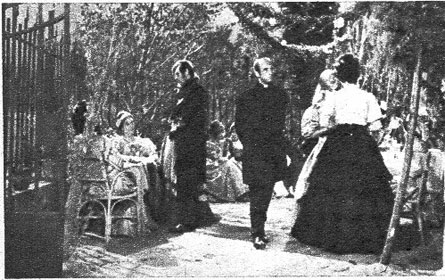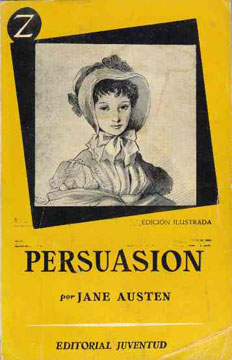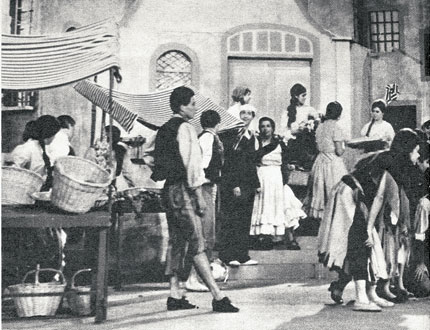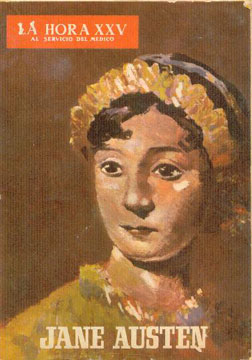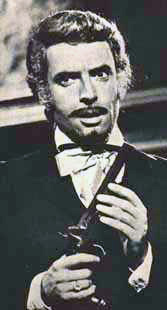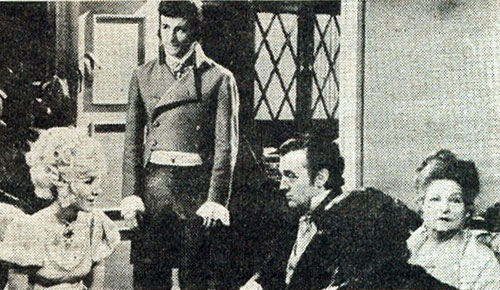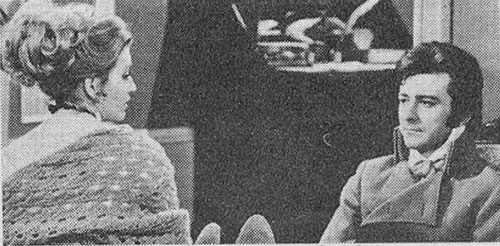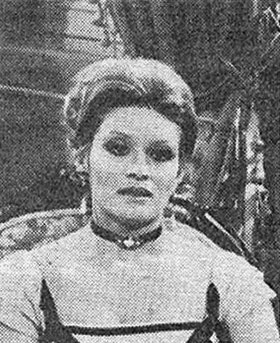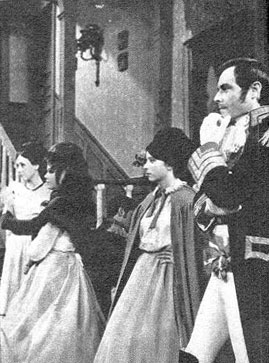|
Apart from a couple of Indian versions, we have grown accustomed to seeing adaptations of Jane Austen’s novels coming from countries whose language is English. This has not always been the case. Television adaptations in other languages date from the middle of the twentieth century. Spain was no exception: Jane Austen was adapted four times from 1966 to 1972, including the first adaptation of Northanger Abbey in the world. This essay will describe these films, as well as the way in which Jane Austen’s books have been characteristically translated and transposed in Spain and other Spanish-speaking countries.
Views
of Austen in nineteenth-century Spain Jane Austen’s novels were not easily
translated into Spanish, whether in Spain or other Spanish-speaking countries
around the world. Translations into other languages like French date from
the beginning of the nineteenth century (Moreno 171), but there were none in
Spanish. As the nineteenth century progressed, there were many French and
a few English novels translated into Spanish (Pajares 345). Spanish
editions of English novels had a double filter: they were translations of French
translations, adaptations adapted again to suit Spanish tastes. Hence
we have a double modification: the change from the original English to the
French taste, and then, again, to the Spanish one, with the additional impositions
of censorship and social demands. Furthermore, French and Spanish readers
of the moment preferred simple stories, without the English moral concepts or
additional subplots usual in English novels: books like Tom Jones were cut to be brief and have
a proper moral according to the beliefs and thoughts of the Spanish and French (Pajares 346). It is likely, then, that Austen was not translated from
French to Spanish because of her ironical point of view; maybe her irony
obscured the moral perspective desired (but not understood) by Spanish editors
at the time. Small circles of nineteenth-century Spanish
readers were aware of Austen’s work. In the middle of the nineteenth
century, the novelist Alcalá Galiano emphasized that the Spanish audience
should know English literature, finding a great common connection in poetry and
drama (García Barrón 158). He considered Austen’s works “safe” reading:
“Miss Austin’s [sic] minor works are very moral,
without being pedantic at all.”1
We find another positive reference to Jane Austen in Manuel de la
Revilla and Pedro de Alcántara Garcia’s Principios generales de literatura e historia
de la literatura española.
Here, in a discussion of satire, Austen does not stand out but is included
among the most distinguished writers: “English literature is richer in these productions;
it offers a great number of notable satirical works, in prose and verse. Swift (1667-1745), Sterne (1713-1768), Lord Byron, Moore, Austin [sic], are the most distinguished
satirists from England. But the usual form of satire there is the novel.”2
One of the
greatest Spanish female writers of the nineteenth century, Emilia Pardon Bazán,
also had an opinion about this English writer. In La Cuestión Palpitante, a work about naturalism admired by Zola, Bazán
wrote an essay about the spreading of modern literary ideas in Spain.3
Here, she discusses Austen within the
context of female authors: “Women started to conquer the territory that now
belongs to them. They used to read with great desire the Moral Tales of miss Edgeworth, and
the names of miss Mary
Russell Milford [sic], miss Austen,
mistress Opie, lady Morgan, mistress Shelly [sic] were starting to sound.”4 Talking
about George Eliot in an appendix to this text, Pardon Bazán also commented on
the influence of being the daughter of a clergyman and the didactic lessons
that these women included in their books: Let us observe the
most known writers, and they owe their lives to ministers, rectors and vicars,
Jane Austen, Jorge Elliot, Frances Trollope (head of the numerous and
celebrated Trollope family of novelists), the very well known Currer, Ellis and
Acton Bell, Eliza Linn Linton, Elizabeth Gaskell (daughter of a reverend and wife
of another, for more signs). . . . But not for that is it less true
what I say about the didactical nature with which those priestesses imprint
their letters.5 Austen’s
novels translated Not until the beginning of the twentieth
century were there Spanish translations of Jane
Austen’s works. Spanish readers had to wait until the publishing house Calpé
included Jane Austen in their collections of Clásicos Universales, along with Tolstoi and Shakespeare. First
was Persuasion in 1919, a risky selection
due to its difficulty of translation (Crespo Allué, La problemática 450). Pride and Prejudice and Northanger
Abbey were published too, and Jane Austen was described as follows: “With
a deep psychology, Jane Austen pierces souls and shows them with naturalness
and a total lack of technical devices, so her novels are perfect narrations,
with penetrating and soft emotion.”6
This description suggests that Jane Austen was considered a psychological
writer who writes about English society and its characters. After that first attempt at
introducing Jane Austen into the Spanish literary world, there were no more
editions until after the Spanish Civil War, during the 1940s. In this decade,
the complete novels were translated with fairly literal titles such as Persuasión, La Abadía de Northanger, Emma,
Orgullo y Prejuicio, Cordura y Sensibilidad, and El Parque Mansfield. We also find Spanish versions of Jane
Austen published in Latin America, with editions from Argentina appearing in
the 1940s and 1950s.7
As years passed, more editions were
published. Some of them—by Manuel Ortega y Gasset (brother of the well
known philosopher), Isabel Oryazabal, or José J. de Urríes de Azara—were new
translations or simply corrections of the first Spanish editions. Because
Jane Austen was unknown to the general reader, the introductions usually gave a
brief biography and they also emphasized the wonderful quality of Jane Austen’s
use of language. Unfortunately, as Díaz Bild remarks about most of the translations,
they tended to distort and even impoverish the original: there were
archaisms, incorrect expressions, awkward syntax, word omissions, distortions of
the original meanings, and even unnecessary changes (191). From 1950 onwards, there were also books illustrated by artists such as Jose Luis Florit and Marta Ribas, among a few others. Florit’s drawings for Pride and Prejudice (Cumbre, 1956) consist of twenty-four lithographs—eight of them with a bit of color—that have a mid-nineteenth-century setting more suitable for Little Women than for Jane Austen. Ribas’s drawings for Persuasion (Juventud, 1958) are beautiful linear sketches in black and white, not only very accurate to the Regency period but also very meaningful.
Beginning in the 1960s, Jane Austen started
to be known more widely due to both television adaptations and the works of several
critics, such as the Mexican writer Sergio Pitol. For instance, in 1978, the
journalist M. José Segura Velasco talked about Austen as an example of the role
of the woman writer, drawing on Austen’s own self-description from her letters: Jane Austen displayed this gift of intelligence,
yet it was not just irony that made her say one day that her work materials
were from the close observation of the life of three or four village families.
With this, she showed an observant talent that was able to handle characters,
status, and, most important, how these elements become adequate as ferment of
her literary creation.8 Although, as we have seen, Austen
has been published in Spain through the years, she was not fully studied in
Spanish universities. According to Díaz Bild, English literature and
language as a university program of study began in Spain in the 1950s, but little
published research appeared until the 1980s (195). And although Austen’s
work is known and studied by undergraduates nowadays, Spanish scholars follow
the main trends in Anglo-American criticism and are not very interested in
research about her work or its influence in Spain itself. By the time, then, that Hollywood turned its cinematic eyes in a sustained way to the writer in the 1990s, Jane Austen had begun to be much more familiar to Spanish and Spanish-speaking audiences. During the 1990s even her lesser works were published, and she was also translated into other languages spoken in some parts of Spain like Catalan, Galician, or Basque. At the moment, it is easy to find her books in paperback “newsagent’s” editions and even her lesser-known works in hardback editions, so we can equate her popularity in Spain to that of the Brontë sisters. Yet, there is a drawback: sometimes the common reader confuses her works with romance novels, something that should be avoided.
The
first Hollywood adaptation The first Austen film adaptation to
be successful in Spain was the 1940 Hollywood film Pride and Prejudice directed by Robert Z. Leonard, released in Spain
in 1945 with the title Más Fuerte Que el Orgullo
(Stronger than Pride). The
world situation was delicate. World War II was over, Europe was
devastated, and Franco’s dictatorship had begun. An example of the film’s
marketing in Spanish newspapers is this description: Five beautiful girls searching for a husband.
One is bold, another dazzling, another astute, another rebellious and one
intelligent. Will they get their goal? Seeing the film will answer
the question. Evocation of a period in which girls who wanted a fiancé had
to sham the contrary. A comedy which will make you laugh, inspired by a
Jane Austen novel read and admired by more than ten million readers.9
Perhaps the Spanish release of the film was one
of the reasons for the publication of Jane Austen’s novels in the 1940s in Spain and Spanish-speaking countries.
European
literature on Novela Before the popularity of the 1990s, Jane
Austen’s novels had of course already been translated to Spanish audiences by
way of the public broadcasting channel—TVE—in the 1960s. The channel,
created in 1956, broadcast programs based on books, a genre derived from the
radio. These shows were so successful—especially drama in Estudio 1 or novels in Novela—that among a population of 30,000,000
(INE), 7% or more of the people used to watch them everyday (Palacio 70)—and not
all households in Spain had a television set. In the 1960s, too, Spain benefited
from the economic advances and new openness of ideas accompanying the Franco
dictatorship during that moment because of the new international recognition of
the country. People started to buy TV sets in order to enjoy TVE, which
concentrated its efforts on shows like quizzes, sports, drama and foreign-produced
series such as The Fugitive and The Saint. Novela,
starting in 1963, adapted famous novels or biographies into 20-minute segments.
It was broadcast daily, from Monday to Friday at 3:40 p.m., with each series extending
to 10 or 20 chapters. The episodes were shown live from Prado del Rey (Madrid)
or Miramar (Barcelona) studios. Since 1964, videotape was used as the
recording system but with the inconvenience that the video devices had to be
connected without stop during the 20-minute periods. Every Monday, at 2
p.m., the recording of the second chapter began, and promptly at 3:40 p.m., the
first chapter was shown live. After finishing it, cast and crew continued
to work until the evening, which meant two or three chapters more (Espín).
The tapes were the two-inch type, and sometimes they were recorded over, so unfortunately
some of these episodes have been lost forever. The chapters and scripts were
supervised by Franco’s censors, who also supervised people’s morals, religion,
and politics. For example, they banned “incorrect” words such as “kingdom”
in Hamlet (Spain had no kings during
its dictatorship), or “vengeance” in El
Conde de Montecristo (The Count of
Montecristo). Kisses on the mouth were banned, so actors would kiss
ears or necks. Ironically, despite the censorship’s intentions and
interventions, the result was often even more romantic or erotic. In 1966, technology advanced but was
still very limited. Big productions using outdoor locations, like El Conde de Montecristo or Little Dorrit, were made. The crew for
these productions was magnificent, with a wonderful cast drawn from the Spanish
cinema or the theatre. Directors like Pedro Amalio López (a Berlin
winner) or Pilar Miró (Berlin & Venice Jury Member and director of El Crimen de Cuenca, among others), and
writers and players such as Antonio Gala (writer of El Manuscrito Carmesí [The Crimson
Manuscript]),
Adolfo Marsillach (star of Ramon &
Cajal, among others), and Fernando Fernán Gómez (winner of Venice Film
Festival in 1984 and one of most famous actors in Spain) took part in these
projects. In 1966, Novela was so successful that it had another, more prominent programming
slot, directly before the evening news bulletin. The recording system for
the nights was slower: two and a half hours of programming were made in
two or three days of work. Jane
Austen’s novels on Spanish television From the years 1966 to 1972, four of
Jane Austen’s novels were adapted and broadcast: Pride and Prejudice, Emma, Northanger Abbey, and Persuasion. These novels were
thought to fit in the moral code of Spanish society, where women’s destiny was
marriage, and where values were based on a traditional Roman Catholic morality.
There was no doubt about the value of marriage or proper feminine behavior in
the novels. A survey of the TVE adaptations of
Austen’s novels follows. For additional information about cast and crew, please
see the appendix.10
Pride and Prejudice (25 April to 6 May 1966, at 9 p.m.) This adaptation of ten chapters was
directed by Alberto González Vergel, who had experience in theatre. The
script was written by José Méndez Herrera, winner of a National Translation
Prize in 1962 for translating the works of Shakespeare (ACETT).
The plot of this adaptation seems to have kept close to the novel: Mrs. Benet (rather than Bennet) tries to marry off the five pretty sisters, and her indiscretion causes the suffering of her daughters. There were, however, some changes made in the adaptation. Some of the characters’ names were altered: Jane became Jenny, Lydia was Lina, and Caroline became Carol. The changes were not random but made in order that the audience could understand British names. These new names were also fashionable in 1960s Spain.
In addition, the sets were closer to Spanish
than to British houses, and costumes were of the 1840s because they were
re-used from other series of Novela.
(In fact, in order to keep production costs down and so that they could be used
again, the scenery and costumes of the first year’s shows were always from the
mid-nineteenth century.) The show was successful, and some
magazines, such as La Hora, even ran
a picture of Jane Austen on the cover in response to the filmic adaptation.
The magazine included passages from the first chapters of Pride and Prejudice and focused on Mr. Collins until he is rejected
by Lizzy. Oddly, there is no mention of Mr. Darcy in this article.
Emma (13 to 24 November
1967, at 3:40 p.m.) Emma was also
composed of ten twenty-minute chapters, and it was directed by Manuel Aguado.
The script was written by Hermogenes Sainz, the playwright who successfully
adapted Nobel laureate Santiago Ramón y Cajal’s biography in 1980. The
action was situated in 1810, beginning as Emma and Mr. Woodhouse complain about
her governess’s marriage. Emma’s
plot seems to be similar to that of Austen’s novel, with the notable exception
of a party organized for the Eltons by Emma, due to Mr. Woodhouse’s pressure.
Again, some characters’ names are changed: for example, Miss Taylor
becomes Ana, and Robert Martin becomes James. Mr. Elton was played by Pastor Serrador, much older than his
character in the novel; Pepe Martín and Lola Herrera—Frank and Jane—would have
the leading roles in Northanger Abbey. Northanger Abbey (25 November to 6 December 1968, at 3:50 p.m.) The first-ever adaptation of Northanger Abbey for television had ten
chapters. It was directed by Pedro Amalio López, a classic TVE director who had
won prizes in Berlin and Montecarlo and who had gained fame with his versions of
Salem’s Witches and Julio Cesar. The adaptation was scripted
by Ricardo López Aranda, a young and prize-winning playwright (“Guiones”).
In it, Catalina (Catherine) and Isabel (Isabella) both fall in love with Henry,
whose mother was killed in the abbey. Catalina wants to fight her fears
in Henry’s house, where she investigates each family member. As in a
detective story, everything is resolved in Northanger Abbey, where Isabel also visits. According to Diario de Barcelona, the female viewers were able to admire the
literary art of one of the best eighteenth- and nineteenth-century English
writers, and they could see the plot trend of the period, of which Jane Austen
was almost a precursor. The critic also emphasized the need for this kind
of adaptation of writers deserving of a prominent place in literary history.
La Abadía de Northanger, Diario’s critic proclaimed, “was a
television exponent of literature.”11
Pepe Martín was a dashing hero. He starred in most of the novels and used to kiss every leading lady—the reason why he was called “el besucón” (the smoocher). Martín became so famous among women for his role as Edmund Dantés in El Conde de Montecristo that his popularity was like that of Colin Firth during the Darcymania of the 1990s.
Due to this extreme success, he went to
Argentina and Chile for a couple of years. Among this adaptation’s
curiosities is an anecdote Pepe Martín recalled in a television show. He recounted
that for this film Lola Herrera, playing Catalina, had sellotape on the ends of
her eyes in order to become, according to the 1960s fashion, more “Eastern-looking”
and attractive. In the final love scene, which had to be recorded in one
take, one of the bits of sellotape fell off. Herrera started to laugh and
cry, holding Martín, who started to laugh too. Because of the way the two
actors embraced and kissed, nobody could see that one of the pieces of tape had
fallen, so everybody congratulated them, thinking that their emotion was their
way of showing their characters’ love—in other words, their good acting (Espín). Persuasion (14 to 25 February 1972,
at 8:30 p.m.) In 1972, TVE underwent more
technical advances; the recording process, for instance, became simpler. Persuasion was shown as the first adaptation
of the Sesión Inglesa (English
Season), in which other British classics were adapted (Baget, Historia 283).
It was shown after The Man Who Laughs by Victor Hugo and before Shirley by Charlotte Brontë. Federico Ruiz directed this
adaptation of ten chapters from a script written by Hermógenes Sainz. Photographs
of the series indicate the use of more authentic period costumes and scenery. In the first episode Ana (Anne), before going to Bath, meets fine Michael Trent, the name that Captain Frederick Wentworth was given in the series. In episode six, Ana goes to Bath, happy about the place but sad about not seeing her love. There her snobbish family wants her to meet real aristocracy, but she goes to see her friend Mrs. Smith. After that, Ana finds out that Admiral Croft is sick and that Michael Trent is travelling to Bath, where they again meet.
Mr. William Elliot is an obstacle for them,
especially during the Bath concert, because Trent becomes jealous. Ana
realizes that everybody thinks she has a relationship with Mr. Elliot, but in
the end everything is solved in Sir Walter’s house, where she says goodbye to
her cousin and meets Michael. I cannot ascertain the existence of Wentworth’s
letter in this adaptation. The oldest Spanish editions of the novel have
the letter, but we do not know if those editions or another with the cancelled chapters (published by R. W.
Chapman in 1926) were used for the adaptation. We can, however,
compare this version to the 2007 ITV Television version, where, as in the
cancelled chapters, the climax is almost in Sir Walter’s house.
The end
of the Novela adaptations The success of this kind of drama
started to diminish in 1972 due to the changing tastes of the Spanish people,
who began to prefer modern adaptations like Death
of a Salesman or short films like La
Cabina, which brought the first Emmy award to the channel (Baget, “40 años” 47). This change in taste could
also be explained by a change in public opinion. The Spanish in the 1970s
lived under a modern dictatorship with a dying Franco; during this time, society
became more open, and other countries, as well as modern social movements, began
to influence Spain. This openness was greater than that of the 1960s
because ethics became relaxed: family values changed, and marriage was no
longer an “obligation” for women. As society had developed, culture
and education had made the viewers more critical. Some discordant voices pled
for accuracy in translations and realism in plots. In the words of José
María Rodríguez, “I don’t know average or accurate adaptations, respectful ones
that keep up the language and original preoccupations of the manipulated novels;
although I don’t deny that there were some of them. . . . I have
attended to the most strange curious murders and shady deals that can be
committed with some degree of ingenuity in the novel of the last century.”12 There was a feeling of boredom with the
conventional dramatic series. According to Díaz-Plaja, “In all the years
I have watched it, all the scenery is from the nineteenth century, all the
characters are sad, and the plots are so complicated. . . . But there
is also another common point in all these novels, and that is their foreign
origin.”13 Since period drama still appealed to
the feminine viewer, it was still shown on television. Its style,
however, went from theatrical to a cinematographic—from stage-like productions to
more naturalistic settings—under the influence of foreign series like The Forsyte Saga or Leonardo DaVinci (Diego 2-3). The
impact of adaptations from Hollywood and Great Britain As I have said above, except for
Leonard’s Pride and Prejudice, no other
adaptations of Jane Austen’s novels were made or shown in Spain until Novela in the 1960s. After the end
of Novela, Grandes Relatos, a new television series, appeared in the late 1970s. It was scheduled from Mondays to
Thursdays at prime time—10:00 p.m.—and featured foreign and Spanish adaptations
of period dramas. In April 1980, the BBC Pride and Prejudice directed by Cyril Coke was televised.
That series was not very successful because it was preceded by Poldark, a tremendous hit, which even
won the popular Tele-Programa Award for “Best Character” in 1980 (“Listado”).
Moreover, during the broadcast of Pride
and Prejudice, TVE was in the midst of a big marketing campaign for a homemade
series: Fortunata y Jacinta, a
remarkable adaptation of the novel by Benito Perez Galdós. Therefore,
when Pride and Prejudice was shown, the
audience was both still under Poldark’s
charm and more interested in the upcoming series. The newspaper El Pais defined the problem: In TVE, Pride
and Prejudice almost walked in on tiptoes, with shy discretion, as though
devastated, [coming just] after the exaggeration of Poldark . . . and on the eve of the Fortunata y Jacinta’s national display. Light years of
cultural and television education will be needed in order to appreciate this product
of rare quality, wonderfully translated into “British,” with exceptional dialogue.
Neither our television nor our audience were ready for this small surprise.
In full Romanticism, even the great master of the historical novel, Sir Walter
Scott, was fascinated by the works of the discreet Jane Austen. For the
Spanish market, it is difficult going from Ivanhoe to the Bennett [sic]
sisters.14
As Villodres remarked, “Pride and Prejudice by the English writer Jane Austen leaves without
pain or glory this week. This perfectionist and surprisingly beautiful work,
especially in shape, atmosphere and scenery, gives way to a Spanish Grandes Relatos this Wednesday.”15 Some
critics seemed satisfied with the adaptation of Austen’s novel. Baget Herms
wrote: It
is justice to mention one more time the refined technique of the BBC producers
and the benefit they derive from their group of excellent actors. . . .
The art of making a novel in its pure state agrees perfectly with the technique
of Jane Austen, who develops the characters and situations with elegance and
finesse and makes easy the task of television script writers. . . . The
talent of the actors—firstly the subtle beauty of Elizabeth Bennett [sic]—does
the rest.16
The Madrid newspaper El País also ran a great introduction to Austen’s works, praising
the series and explaining the Spanish vision of the writer and the series: Who cares about the dull adventures
of five British young ladies from the rural gentry, obsessed with marriage, in
the beginning of the nineteenth century? In that moment, gothic novels took
priority in Great Britain. . . . Nothing is more opposite in appearance
to the romantic spirit of [Austen’s] six novels. . . . But the works of
Jane Austen seem to acquire tradition as time goes by, and even oblivion is
good for them. Not long ago José María Valverde proposed to Spanish
audience a new reading of another of her books, Emma, pointing out that it was the best English novel of the
nineteenth century. . . . A happy heritage from the past that today
appears so unhappy. . . . Austen’s books have psychological
refinement, some gradations of almost imperceptible shade, a hidden irony, and,
sometimes, pictures of restrained cruelty. Her economical and social analysis
anticipates Victorian society, and her formal Puritanism shows a moderate and
smiling skepticism.17
Despite this praise of Austen’s
depth of psychology and artistry, however, the series did not find an audience.
TVE thought that any British period drama was a warranty of good taste and
success, but this adaptation was too brainy for the audience. Lacking the
passionate elements of Poldark, it was not well received. As Elizabeth Bennett [sic] said to
her aunt, after bumping into Mr. Darcy in her first visit to Pemberley: “coming
here was the most unfortunate, the most ill-judged thing I have done.” But
the only thing which can save us from abjectness, come hell or high water, is
showing these products of rare quality.18 The insistence on British drama series
through the entire year made Grandes
Relatos fail. The dramas were not as good as others shown before, and
people became dissatisfied. There were no other channels but TVE, and the
over-use of these drama shows made the negative criticism grow greater every
day. When Persuasion, directed by
Howard Baker, was shown in November, with a grey introduction that defined Jane
Austen as a dark and sad spinster, there were negative comments (Crespo Allué, “Algunas
ideas” 299). At least some of these views recognized Jane Austen’s work,
but the lack of quality of this old adaptation of Persuasion made the critics angry with it: It is seen that the sirs from Pandora’s Box are
devoted to systematically wearing a matter out. . . . The fact is
that Pandora’s Box has opened, and a series of boring vices has jumped out from
it, directed toward Great Britain.19 Next week Persuación
[sic] looms over us. . . . [W]e crave something lighter. . . .
[F]rankly, the old-fashioned loves of English naval captains, after having
beaten French and Spanish armies at Trafalgar, are what we don’t crave.
Undoubtedly, the novel Persuasion
from Jane Austen—one of the greatest writers in English language from the
nineteenth century—does not persuade us. We are a bit satiated with unwilling
love.20
A production, equal in achievement to similar
series on the three British channels, is arriving on Televisión Española after
the absurd delay of eleven years. The TV film comes at the worst moment in
the schedule of Grandes Relatos:
on one hand, there is an inflation of British series, which TV schedulers piled
up during the last two months, with scarce consciousness of moderation, abundant
in similar subjects and periods; and on the other hand, the shocking drop in
the ratings of the show. The last two waves that TVE has announced reveal
that Grandes Relatos is below average,
among the least accepted shows. . . . It will probably disappear in
the coming January.21 The insistence on and over-use of British
period series ensured that people, wanting to see another kind of TV series and
miniseries, were exhausted by nineteenth-century British period drama. British
period drama, then, became completely forgotten in television during the
decade. Viewers had to wait years for
another adaptation, indeed until the tremendous success of Ang Lee’s Sense and Sensibility (1995). After that film won great awards, and
after period films like Kenneth Branagh’s Much
Ado About Nothing and Merchant-Ivory’s The
Remains of the Day became popular, film distributors supported the
distribution in Spain of Sense and
Sensibility, which had a good audience and wonderful reviews.22
Austen became more popular with
Spanish film audiences and with future readers. Further, the new fashion for
period films ensured that other Austen films were released in Spain: Doug
McGrath’s Emma, Patricia Rozema’s Mansfield Park, and even a limited
distribution of Roger Michell’s Persuasion. Unfortunately, there were no similar
chances for TV adaptations in Spain. Simon Langton’s 1995 Pride and Prejudice and Diarmuid
Lawrence’s 1996 Emma were shown on
cable television, and the former was quite successful among readers who looked
for it, thanks to internet information and the influence of books like Bridget Jones’s Diary. Unluckily, Pride and Prejudice was not released on
DVD in Spain until 2004 and in Mexico not until 2006. Currently, Spanish-speaking
audiences can see major Hollywood films such as the 2005 Pride & Prejudice in cinemas when they are released. The
success of films like this one in Spain has made DVD distributors want to
release British series or television films like BBC’s North and South and Middlemarch.
Because period drama is becoming more popular and again has an audience, Spanish
audiences can now find these kinds of period adaptations on cinema, cable television,
or DVD.
Although there have been some TVE adaptations
of Spanish novels in the last decade—adaptations that were more attractive and
satisfying
than old productions—, the last big production was of the late-nineteenth-century
realist novel La Regenta, in 1995 (Ruscalleda). These productions diminished when the existence of private
and cable channels, which produced modern series about Spanish families like Farmacia de Guardia or Médico de Familia, caused a crisis for
TVE. These more contemporary series were very successful and proposed a new
model of family life. This success lasted until the first decade of the
new century, when the family model changed again. Since then, television has
been constrained by the decadence of a postmodernist media with little patience
for traditional narratives or historical fiction, particularly those with happy
endings. Consequently, nowadays, it is quite
difficult to watch Spanish versions of Austen’s masterpieces. Spanish cinema
and television prefer modern urban stories, so period drama is almost nonexistent,
except for films such as El Abuelo or
Alatriste, which try to import the
book into the audience’s contemporary life and include anachronistic, modern perspectives.
The only Spanish-made period dramas available are, like Pan’s Labyrinth, mainly about the Spanish Civil War. Meanwhile,
Spanish-speaking audiences can see major Hollywood films such as the 2005 Pride & Prejudice, which attracts
international fame and influence. While Spanish television viewers were introduced to Jane Austen within the very first years of the medium, the over-use of British period drama made broadcasters see the genre as a risky and unprofitable, so it was never pursued again. No more television productions were made, and there were no more attempts to buy foreign television productions. The general acculturation of Spanish society through the centuries kept it away from classic writers and their works. Even the publication of Austen’s books did not seem profitable until the production of cinema adaptations showed that her works could attract audiences. According to this dynamic, readers demand the publication of popular films and series, rather than films and series being dependent upon the success of the novels, as was the case with Harry Potter in the U. S., for example. Though a low level of interest in nineteenth-century British literature is still the situation in Spanish speaking countries, the distribution of these stories through the media has helped overcome it a bit. Many people now share conversations via internet, which has become a powerful medium to share Austen’s art with a great number of Spanish-speaking readers from different parts of the world—Mexico, Peru, Colombia, Argentina, Chile, Spain and others—new communities united, thanks to this great writer. The conversations are about books, characters, editions, and films, among other topics. Nowadays, Jane Austen is more known than ever among Spanish-speaking readers, who dream with her love stories and savor her witty and ironical point of view, both timeless and universal.
Cast and crew of Spanish Productions (information from Tele Radio [1966]
and Tele-programa [1967, 1968, 1972])
ACKNOWLEDGEMENTS I started this paper in September 2006 due to a personal interest in and
admiration of Jane Austen and a curiosity to read research or works about her
in Spanish. From that time onwards I have been helped and encouraged by
some people I would like to acknowledge: Andrés Martínez and his wife,
Carlos Ruscalleda, Aída Díaz Bild, Verónica López-Aranda, Susana Tezanos,
the ‘burgomaestres’ from Lady Filstrup, Rocío Berlanga, Alejandro López, the
great Cinthia García, and the wonderful Almudena Romero. Of course, there
are other important people such as my family and friends, JACastellano and
other austenitas, and the librarians
from the University of Málaga and the Archivo Municipal, who were really kind. Special thanks to Inger Sigrun Brodey and Susan
Allen Ford, without whom this essay would have been impossible to complete. NOTES 1. “Cuyas
obrillas son muy morales sin ser fuera del todo, ni de modo alguno pedante” (qtd.
in Moreno 174). 2. “Más rica en
producciones de este género la literatura inglesa, ofrece gran número de obras
satíricas notables, en prosa y en verso. Swift (1667-1745), Sterne
(1713-1768), Lord Byron, Moore, Austin[sic],
son los más distinguidos satíricos de Inglaterra. Pero la forma que
habitualmente toma allí la Sátira, es la novela” (Revilla and Alcántara, Lección
LIII). 3. La
Cuestión Palpitante was a controversial book in nineteenth-century Spain
because it showed new ideas like naturalism against conservativism. Emile
Zola said about it: “It is a very well done book, of fiery controversy:
it does not seem a lady’s book. Those pages can not be written in a
dressing room. . . . The book has chapters of great interest and in
general, it is an excellent guide for those who travel through the regions of
naturalism and who do not want to get lost in its dilemmas or obscure turns.
I can not hide my astonishment in the fact that Mrs. Pardo Bazán is Catholic, a
fervent militant, and at the same time a naturalistic writer; and I can only explain
it from what I hear—that the naturalism of that lady is purely serious,
artistic and literary” (qtd. in Escobar). [“Es libro muy bien hecho, de
fogosa polémica: no parece libro de señora. Aquellas páginas no han
podido escribirse en el tocador. . . . Tiene el libro capítulos de
gran interés y, en general, es excelente guía para cuantos viajen por las
regiones del naturalismo y no quieran perderse en sus encrucijadas y oscuras
revueltas. Lo que no puedo ocultar es mi extrañeza de que la señora pardo
Bazán sea católica, ferviente militante, y a la vez naturalista; y me lo
explico sólo por lo que oigo decir de que el naturalismo de esa señora es puramente formal, artístico y literario.”] 4. “Comenzaban las mujeres a conquistar el territorio que hoy
señorean, y se leían con afán los Cuentos Morales de miss Edgeworth,
y sonaban los nombres de miss Mary Russell Milford, miss Austen, mistress Opie, lady
Morgan, mistress Shelly” (Pardo Bazán, Ch. 17 “En Inglaterra”). 5. “Pues
fijémonos sólo en las novelistas más conocidas, y resulta que deben el
ser a ministros, rectores y vicarios, Jane Austen, Jorge Elliot, Frances Trollope (tronco de la
numerosa y célebre familia novelista Trollope), las tres nombradísimas Currer,
Ellis y Acton Bell, Eliza Linn Linton Elizabeth Gaskell (hija de un reverendo y mujer de otro, por más
señas). . . . Mas no por eso es menos cierto lo que digo del carácter
predicador que aquellas diaconisas imprimen a las letras” (Pardo Bazán, Appendix: “Respuesta a la
epístola del señor marqués de premio-real”). 6. “De una
profunda psicología, Jane Austen cala las almas y las expone con una sencillez
y una ausencia total de aparatos técnicos que hacen de sus novelas narraciones
perfectas, de penetrante y suave emoción” (Orgullo y Prejuicio,
Calpé introduction). 7. See the list of translations at the end of
this essay. For more references, see Romero Sánchez and Romero Sánchez or
“Iberlibro.” 8. “Ya Jane Austen
desplegaba este don de la inteligencia, pues no fue solo ironía lo que la hizo
decir en cierta ocasión, que sus materiales de trabajo los extraía de la
observación perspicaz de la vida, de tres o cuatro familias aldeanas. Con
ello nos demostraba el talento observador capaz de manejar personajes,
situaciones y lo que es más importante, como con estos elementos llegar luego a
la utilización adecuada usándolos como fermento en su creación literaria”
(Segura 7). 9. “Cinco preciosidades de
muchachas en busca de marido. Una es atrevida, otra deslumbrante, otra
astuta, otra rebelde y una inteligente. ¿Consiguen su propósito? La
visión del film contestará esta pregunta. Evocación de una época en que
las muchachas deseaban encontrar novio simulaban todo lo contrario. Una
comedia que provoca la risa, inspirada en la novela de Jane Austen, leída y
admirada por más de diez millones de lectores” (Teatro Cervantes). 10. Unfortunately, I was not able to see any of
the adaptations because TVE’s warehouse does not have open access, and the
films aren’t available for purchase. I have, however, found out that
copies of all the series but Pride and
Prejudice exist. 11. “Durante su desarrollo de diez capítulos, el público
femenino ha tenido la ocasión de admirar el arte literario de una de las más
grandes escritoras inglesas de los siglos XVIII-XIX. Con tal novela, las
telespectadoras han podido conocer las tendencias argumentales que privaban en
aquel tiempo y de las que Jane Austen fue casi precursora. Nos agradaría
que Novela estuviese dedicado
íntegramente, en todas sus ediciones, a difundir las obras de aquellos
escritores que han merecido ocupar un lugar preminente [sic] en la historia de
la literatura. . . . La Abadía
de Northanger responde a lo que debiera ser Novela: un exponente televisivo de la literatura” (Saga). 12. “Términos medios, o sea
adaptaciones adecuadas, respetuosas, que conservan el lenguaje y preocupaciones
originales de la novela manipulada, yo no conozco, aunque no niegue que las
haya habido. . . . He asistido a los asesinatos y componendas más
raras y curiosas que puedan cometerse con cualquier ingenio de la novela del
siglo pasado” (Rodríguez 67). 13. “Porque en los años que
llevo viéndolo, todos los ambientes son del siglo XIX, todos los personajes
están tristes y los temas son tan complicados. . . . Pero además hay
otra característica común en todas esas novelas y es su origen extranjero” (Díaz-Plaja 111-12). 14. “En Televisión, Orgullo
y Prejuicio ha pasado casi de puntillas, con una discreción tímida y como
desolada, tras las alharacas de Poldark . . .
y en vísperas del despliegue nacional de Fortunata y Jacinta. . . .
Hacen falta siglos-luz de educación cultural y televisiva para apreciar este
producto de rara calidad, prodigiosamente vertido ‘a la británica,’ y con un
diálogo excepcional. Ni
nuestro medio, ni nuestro público estaban preparados para esta pequeña
sorpresa. En pleno romanticismo, hasta el gran
maestro de la novela histórica, sir Walter Scott, se mostraba fascinado por los
libros de la discreta Jane Austen. Para el mercado español es dificil
pasar de Ivanhoe a las hermanas Bennett [sic]” (Conte). 15. “Esta semana se nos
marcha sin pena ni gloria ‘Orgullo y Prejuicio’ de la escritora inglesa Jane
Austen. Esta obra perfeccionista y sorprendentemente bella, sobre todo en
la forma, ambientes y decorados deja paso, el miércoles a unos ‘Grandes
Relatos’ españoles” (Villodres). 16. “Es de justicia
mencionar una vez más, la depurada técnica de los realizadores de la BBC y el
provecho que sacan de su excelente cuadro de actores. . . . El arte
de novelar en su estado puro cuadra perfectamente con la técnica de Jane Austen
que desarrolla los personajes y las situaciones con elegancia y finura y
facilita por ello la labor de los adaptadores al medio televisivo.
. . . El talento de los actores—con la sutil belleza de Elizabeth
Bennett en primer término—hace el resto” (Baget Herms, “Orgullo” 75). 17. “¿A quién pueden
interesar las anodinas aventuras de cinco jovencitas británicas de la pequeña
clase media rural, obsesionadas por el matrimonio, a principios del siglo XIX?
En aquel entonces, en Gran
Bretaña primaban las llamadas novelas góticas. . . . Nada más opuesto en apariencia al espíritu romántico que las seis
novelas. . . . Pero las obras de Jane Austen parecen cobrar solera
con el paso del tiempo, y hasta el olvido les sienta bien. Hace poco José
María Valverde proponía al público español una nueva lectura de otro de sus
libros, Emma, señalando que tal vez
se trataba de la mejor novela inglesa del siglo XIX. . . . Feliz
herencia de un pasado que hoy se nos aparece tan infeliz. . . . En
los libros de la Austen hay una finura psicológica excepcional, unas gradaciones
de matices casi imperceptibles, una soterrada ironía y a veces retratos
comedidamente crueles. Sus análisis económicos y sociales preludian la
sociedad victoriana, y su puritanismo formal transluce un escepticismo moderado
y sonriente” (Conte). 18. “Lo más probable es que
la serie no haya gustado demasiado. . . . Como dijo Elizabeth Bennett
[sic] a su tía, tras tropezar con el señor Darcy en su primera visita a
Pemberley: ‘Venir aquí ha sido lo más desafortunado que he podido
hacer.’
Pero sólo nos puede salvar de la abyección la insistencia, contra viento y
marea, en presentar productos de esta rara calidad” (Conte). 19. “Está visto que los señores de la Caja de Pandora se
dedican sistemáticamente a machacar un tema. . . . El hecho es que la
caja de Pandora se ha entreabierto y de ella han saltado una serie de vicios
púmbleos, dirigidos hacia la Gran Bretaña” (“La Caja de Pandora”). 20. “Esta semana se cierne
sobre nosotros ‘Persuación’ [sic]. . . . [N]os apetecía algo más
ligero. . . . Y francamente, los amores demodés de los capitanes de
Marina inglesa, después de haber batido a franceses y españoles en Trafalgar,
pues no apetece. Indiscutiblemente, la novela Persuasión, de Jane Austen—una
de las grandes novelistas en habla inglesa del siglo XIX—no nos persuade.
Estamos un poco saciados de amores a contrapelo” (“La Caja de Pandora”). 21. “Una obra a la altura
de productos similares de las tres cadenas británicas, pero que llega a
Televisión, Española con el absurdo retraso de once años. El telefilme
viene además en un pésimo momento para la programación de Grandes relatos: por una parte, debido a la
inflación de series británicas que los directivos apelotonaron en los dos
últimos meses, con escaso sentido de la medida, abundantes en temáticas y
épocas análogas y, por otra parte, el escandaloso descenso en el panel de
aceptación de programas. Las dos últimas oleadas hechas públicas por RTVE
revelan que el espacio Grandes relatos se situó por de bajo de la media, entre
los de peor aceptación. . . . La fórmula probablemente desaparecerá
en el próximo mes de enero” (P. O.). 22. “The film distributors of Sense and Sensibility (Albéniz) have waited until now to include it on the marquee due to the promising outlook of the film at this moment of successive awards.” (Albéniz was the name of the movie theater where Sense and Sensibility was shown in Málaga). [“Los distribuidores de “Sentido y Sensibilidad” (Albéniz) han esperado hasta ahora para incluirla en la cartelera ante las buenas perspectivas del film de cara a esta época de sucesivos repartos galardones” (Griñán 67)] Books and Articles
Cited ACCET. “Premios Nacionales de
Traducción:
primera etapa.” ACETT 2007. 28 July
2007 http://www.acett.org. Baget Herms, Josep Maria. “40 años de
nuestra TVE.” La Vanguardia 27
Oct. 1996. _____. Historia de la televisión en España
(1956-1975).
Barcelona: Universitat Autònoma de Barcelona, 1992. _____.
“Orgullo y Prejuicio.” La
Vanguardia 6 May 1980: 75. “La Caja de Pandora.” Diario Sur [Málaga] 16, 23 Nov. 1980. Crespo Allué, María José. La
problemática de las versiones españolas de Persuasión de Jane Austen:
crítica de su traducción. Valladolid: Universidad de Valladolid, 1981. _____. “Algunas ideas sobre la adaptación a la pequeña pantalla de Persuasión de Jane Austen.” ES: Revista de filología inglesa 11
(1980): 295-324. Conte. “Un pequeño
gran relato.” El País [Madrid]
7 May 1980. Díaz Bild, Aida. “Still the Great
Forgotten? The Reception of Jane Austen in Spain.” The Reception of Jane Austen in Europe.
Ed. Anthony Mandal and Brian Southam.
London: Continuum, 2007.
188-204. Díaz-Plaja, Fernando. La pantalla chica. Barcelona: Plaza & Janés, 1974. 111-14. Diego, Patricia. “La producción de miniseries durante la etapa
hegemónica de TVE (1956-90).” Navarra: Universidad de Navarra, 2005. 29
Feb. 2008 www.unav.es/fcom/cicom/PDF%20Comunicaciones/grupo%204/patricia%20diego.pdf. Escobar, Julia. “La
Cuestión Palpitante.” Libertad
Digital S. A. 2002. 7 Dec. 2007 http://revista.libertaddigital.com/articulo.php/1275320277. Espín, Manuel, dir. “Los géneros la
Televisión: Los años dorados del teatro.” La aventura del saber. TVE, Madrid. 26 Oct. 2006. Fielding, Helen.
Bridget Jones’s Diary. London: Picador, 2001. García Barrón, Carlos. La obra crítica y literaria de Don Antonio Alcalá Galiano. Madrid: Gredos, 1970. 153-88. Griñán, Francisco. “El cine en Málaga.” Diario Sur [Málaga] 1 Mar. 1996: 67. “Guiones de televisión.” Ricardo López Aranda 2007.
1 July 2007 http://www.lopez-aranda.com/guiones-television.php. La Hora XXV [Barcelona] July 1966. “Iberlibro: libros nuevos, antiguos, agotados
y de ocasión.” IBERLIBRO 2007. 12 Dec 2007 http://www.iberlibro.com INE. “Demografía y población.” INE 2007. 30 May 2007 http://www.ine.es “Listado de los TP de Oro 1979.” Wikipedia 2007. 12 Dec. 2007 http://es.wikipedia.org/wiki/Premios_TP_de_Oro_1979. Moreno
Hurtado, Antonio. Jane Austen, Juan
Valera y Henry James. Alicante:
Biblioteca Virtual Miguel de Cervantes, 2005.
171-96. P.
O. “La Tribuna.” El País
[Madrid] 7 Nov. 1980. Pajares,
Eterio. Censura y Nacionalidad en
la traducción de la novela inglesa. Alicante: Biblioteca Virtual Miguel de
Cervantes, 2007. 345-52. Palacio, Manuel. Historia de
la televisión en España. Barcelona: Gedisa, 1992. Pardo Bazán, Emilia. La Cuestión Palpitante. Salamanca:
Anaya, 1970. Pitol, Sergio. Siete escritores ingleses: de Jane Austen a Virginia Woolf. México: SepDiana, 1982. Revilla, Manuel de la, and Pedro Alcántara
Garcia. Principios generales
de literatura e historia de la literatura española. Alicante: Biblioteca Virtual Miguel de Cervantes, 2000. Rodríguez, José María. Carta abierta a Televisión Española. Madrid: Ediciones 99, 1973. 57-71. Romero Sánchez, Almudena,
and Mari Carmen Romero Sánchez. “Ediciones Antiguas.” El Sitio de Jane Austen 2007. 10 Dec.
2007 http://janeausten.zxq.net/edic.htm.
Ruscalleda, Carlos. “Las Grandes Series. Prestigio para TVE.” 50 años de TVE en el Telediario. Televisión Española 2006. 7 Mar. 2008 http://www.rtve.es/tve/50_aniversario/20060625_blog50anyos.htm Saga. “Reflejos de TV.” Diario de Barcelona 8 Dec. 1968. Segura Velasco, M. José. “La mujer en la literatura.”
Diario Sur [Málaga] 21 May 1978: 7. Teatro Cervantes. “Más fuerte que el Orgullo.” Diario Sur [Málaga] 27 Feb. 1945: 2. Tele Radio [Madrid] 1966. Tele-programa [Madrid] 1967, 1968, 1972. Villodres, Carmen. “Fortunada y Jacinta, de
Galdós, en Grandes Relatos.” Diario Sur [Málaga] 4 May 1980: 37. Translations Cited Austen, Jane. La Abadía de Northanger. Colección Universal. Madrid: Calpé, 1921. _____. La Abadía de Northanger. Madrid. Novelas y Cuentos, 1946. _____. La Abadía de Northanger. Buenos Aires: Espasa Calpé, 1951. _____. Cordura y Sensibilidad. Trans. Fernando Durán. Barcelona: Regueras, 1946. _____. Emma. Trans. Jaime Bofill y Ferro. Barcelona: Arimany, 1945. _____. Orgullo y Prejuicio. Colección Universal. Madrid: Calpé, 1924. _____. Orgullo y Prejuicio. Madrid: Novelas y Cuentos, 1949. _____. Orgullo y Prejuicio. Colección Universal. Madrid: Calpé, 1924. _____. Orgullo y Prejuicio. Buenos Aires: Juventud, 1945. _____. Orgullo y Prejuicio. México: Cumbre, 1959. _____. El parque de Mansfield. Trans. Guillermo Villalonga. Barcelona: Tartessos, 1943. _____. Persuasión. Trans. M. Ortega y Gasset. Colección Universal. Madrid: Calpé, 1919. _____. Persuasión. Barcelona: Surco, 1945. _____. Persuasión. Barcelona: Juventud, 1958. Film and Video Cited La Abadía de Northanger. Dir. Pedro Amalio
López. TVE. 1968. El Abuelo. Dir. José Luís Garci. RTVE. 1998. Alatriste. Dir. Agustín Díaz Yanes. Estudios Picasso. 2006. La Cabina. Dir. Antonio Mercero. TVE. 1972. El Conde de Montecristo. Dir. Pedro Amalio López. TVE. 1969. El Crimen de Cuenca. Dir. Pilar
Miró. In-Cine.
1981. Death of a Salesman. Dir. Pedro Amalio López. TVE. 1972. Emma. Dir. Manuel Aguado. TVE. 1967. Emma. Dir. Douglas McGrath. Miramax.
1996. Emma. Dir. Diarmuid Lawrence. Meridian
Broadcasting. 1996. Farmacia de Guardia. Dir. Vicente Escrivá. Antena 3 Televisión. 1991. The Forsyte Saga. Dir. James Cellan Jones and David Giles. BBC. 1967. Fortunata y Jacinta. Dir. Mario Camus. RTVE. 1980. The Fugitive.
Dir. Roy Huggins. Quinn Martin Productions.
1963. Hamlet. TVE. 1970. Julio Cesar. Dir. Pedro Amalio
López. TVE. 1965. Little Dorrit—La pequeña Dorrit. Dir. Pilar Miró. TVE. 1965. Leonardo DaVinci. Dir. Renato Castellani. RAI. 1971. The Man Who Laughs. TVE. 1972. Mansfield Park. Dir. Patricia Rozema. Miramax. 1999. Médico de Familia. Dir. Guillermo Fernández Groizard. Estudios Picasso. 1995. Middlemarch.
Dir. Anthony Page. BBC. 1994. Much Ado About Nothing. Dir. Kenneth Branagh. BBC. 1993. North and South. Dir. Brian Percival. BBC. 2004. Orgullo y Prejuicio. Dir. Alberto González
Vergel. TVE. 1966. Pan’s Labyrinth. Dir. Guillermo del Toro. Tequila Gang. 2006. Persuasion. Dir. Howard Baker. Granada Television. 1971. Persuasion. Dir. Federico Ruiz. TVE. 1972. Persuasion. Dir. Roger Michell. BBC. 1995. Persuasion. Dir. Adrian Shergold. Clerkenwell Films. 2007. Poldark.
Dir. Christopher Barry. BBC. 1975. Pride and Prejudice. Dir. Robert Z.
Leonard. MGM. 1940. Pride and Prejudice. Dir. Cyril Coke. BBC. 1980. Pride and Prejudice. Dir. Simon Langton.
BBC and A&E
Television. 1995. Pride & Prejudice. Dir. Joe Wright.
Focus Features. 2005. Ramon y Cajal. Dir. José María Forqué. TVE. 1982. La Regenta. Dir. Fernando Méndez Leite. Classic Films. 1995. The Remains of the Day. Dir. James Ivory.
Merchant Ivory. 1993. The Saint. Dir. John Ainsworth. Bamore. 1962. Salem’s Witches. Dir. Pedro Amalio
López. TVE. 1965. Sense and Sensibility. Dir. Ang Lee.
Columbia Pictures. 1995. Shirley. TVE. 1972. |
||||||||||||||||||||||||||||||||||||||||||||||||||||||||||||||||||||||||||||||||||||||||||||||||||||||||||||||||||||||||||||||||||||||||||||||||||||||||||||||||||||||||||||||||||||||||||||||||||||||||||||||||||||||||||||||||||||||||||||||||||||||||||||||||||||||||||||||||||||||||||||||||||||||||||||||||||||||||||||||||||||||||||||||||||||||||||||||||||||||||||||||||||||||


